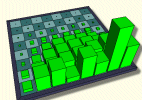


ChessBase 17 - Mega package - Edition 2024
It is the program of choice for anyone who loves the game and wants to know more about it. Start your personal success story with ChessBase and enjoy the game even more.
 Castling
to win
Castling
to winThe King is the most valuable piece on the chess board, yet many players give little thought to where His Majesty should reside. Timmer's survey explains the dangers of leaving the King in the center, and the possible drawbacks to castling too early, too late or on the wrong side but also explains when you should castle early or late and whether to go Kingside or Queenside. You can order this entertaining little book ($23.95, special price for the week March 6-12: $13.95) here.
You may not know this, but our database program ChessBase offers excellent research facilities on the subject as well. Take for instance the "piece probability" function. It is excuted in the games list: simply mark a bunch of games, right-click and execute the funtion from the context menu that appears. We did this for the 2,018,426 games contained in our Mega 2002 database. This causes ChessBase to play through all those two million games and record the squares to which individual pieces moved. The results are displayed in nice 3D graphics.

In the above example the statistics for the white king are displayed. The program has calculated on which squares the king spent most of its time – during the period from move 10 to move 80. As you can see the square g1 is the easy winner, indicating that most modern players castle kingside.

Here's the display for the black king, which not surprisingly also prefers g8.
Here's another interesting function. Using the "Manoeuvres" tab in the search mask you can find games in which one or both sides did not castle.

In the above example we are seaching for games in which the white king did not move from e1 to g1 or from e1 to c1, between moves 1 and 80. The result: in 181,993 out of 2,018,426 games (= 9%) White did not castle. You may be interested to know that in 63,463 games neither side castled.

This is where the white king went when it did not castle. Interesting that g1 still is a favourite square.
Tim Krabbé, the renowned Keeper of Chess Records, tells us that the
latest
castling came in Neshewat-Garrison, Detroit 1994, where Black played 48...0-0.
The latest queenside castling, 46...0-0-0, occurred in Mitenkov-Strukov, Geller
memorial USSR 1999. The greatest number of castlings in a single game, Tim tells
us, is three. It happened in the following jewel:
Heidenfeld - Kerins, Dublin 1973: 1.e4 e6 2.d4 d5 3.Be3 Nf6 4.e5 Nfd7 5.f4 c5 6.c3 Nc6 7.Nf3 Qb6 8.Qd2 c4 9.Be2 Na5 10.0-0 f5 11.Ng5 Be7 12.g4 Bxg5 13.fxg5 Nf8 14.gxf5 exf5 15.Bf3 Be6 16.Qg2 0-0-0 17.Na3 Ng6 18.Qd2 f4 19.Bf2 Bh3 20.Rfb1 Bf5 21.Nc2 h6 22.gxh6 Rxh6 23.Nb4 Qe6 24.Qe2 Ne7 25.b3 Qg6+ 26.Kf1 Bxb1 27.bxc4 dxc4 28.Qb2 Bd3+ 29.Ke1 Be4 30.Qe2 Bxf3 31.Qxf3 Rxh2 32.d5 Qf5 33.0-0-0 Rh3 34.Qe2 Rxc3+ 35.Kb2 Rh3 36.d6 Nec6 37.Nxc6 Nxc6 38.e6 Qe5+ 39.Qxe5 Nxe5 40.d7+ Nxd7 0-1.